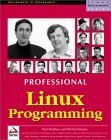What do you think?
Rate this book


1200 pages, Paperback
First published September 1, 2000
This is a mammoth (1000+ pages) introduction to many different technologies available under Linux including databases, languages, GUIs, programming libraries, and more.
This book was written by a team of 14 or so people, who each wrote one or two chapters. Consequently, the book feels more like a collection of conference proceedings than a unified text. Specifically, the style, quality, and approach vary widely from chapter to chapter.
I don't really like books like this. I prefer reading a consistent voice on a focused topic. For quick-and-dirty introductions to new technologies, I think the Web is a better resource.